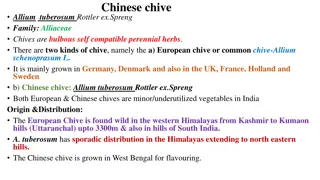Chinese chive
Chinese chives, scientifically known as Allium tuberosum, are bulbous perennial herbs that are underutilized in India. They are cold-hardy plants that prefer temperatures between 17°C and 25°C and well-drained soils with a pH range of 6-7. Chinese chives have multiple culinary uses due to their mild garlic-like flavor and are rich in vitamins, fiber, minerals, and sulfur compounds. They are also valued for their medicinal properties, including potential anticancer activity. Propagation is typically done through division of clumps, with an average yield of 7-8 tonnes per hectare.
Download Presentation

Please find below an Image/Link to download the presentation.
The content on the website is provided AS IS for your information and personal use only. It may not be sold, licensed, or shared on other websites without obtaining consent from the author.If you encounter any issues during the download, it is possible that the publisher has removed the file from their server.
You are allowed to download the files provided on this website for personal or commercial use, subject to the condition that they are used lawfully. All files are the property of their respective owners.
The content on the website is provided AS IS for your information and personal use only. It may not be sold, licensed, or shared on other websites without obtaining consent from the author.
E N D
Presentation Transcript
Chinese chive Allium tuberosum Rottler ex.Spreng Family: Alliaceae Chives are bulbous self compatible perennial herbs. There are two kinds of chive, namely the a) European chive or common chive-Allium schenoprasum L. It is mainly grown in Germany, Denmark and also in the UK, France, Holland and Sweden b) Chinese chive: Allium tuberosum Rottler ex.Spreng Both European & Chinese chives are minor/underutilized vegetables in India Origin &Distribution: The European Chive is found wild in the western Himalayas from Kashmir to Kumaon hills (Uttaranchal) upto 3300m & also in hills of South India. A. tuberosum has sporadic distribution in the Himalayas extending to north eastern hills. The Chinese chive is grown in West Bengal for flavouring.
Botany Chive is a diploid (2n=16), cross pollinated, self compatible and insect pollinated perennial herb. The Chinese chive (A. tuberosum) has chromosome number 2n=32. The plants forms a small bushy clumps & propagated by means of tillers(development of new shoots(lateral bulbs) from base of mother plant) Poorly developed bulbs are ovoid-oblong, about 1-3cm long forms in clusters at the base of the plant. Flower initiation is dependent on low temperature &short day length. Flowering does not takes place if temperatures are above 18 C. The umbel inflorescence has a round and hollow scape, 20-60cm tall. Flowers are purple. pink or white in colour are also found. Flower anthesis starts from the top of the umbel. Its crosspollinated but selfing also occurs.
Importance &uses . The CC (Allium tuberosum) is a perennial plant cultivated in many countries in Asia But it is still minor vegetable in India. These are small perennial bushy clumps & tube like leaves Uses: Leaves having mild garlic like flavour, rich in vitamins, fibre, mineral and sulphur compounds that have antibiotic properties. Its leaves are used in salad, and for flavouring and for garnishing various dishes. Many times the dehydrated leaves used for future seasoning of dishes. The bulbs are produced by the plans are used with leaves in salad or cooking. It is low in calories but rich in beneficial nutrients, vitamins, minerals and antioxidants. The leaves and seeds are often used in traditional folk medicines for treatment of impotence and nocturnal emission in China (Hu et al.,2009) Thiosulfiates-anti cancer activity.
Soil & climatic requirements Chives are cold hardy but tolerant to high temperature Optimum temperatures are between 17 C and 25 C. It can tolerate wide range of soil conditions but fertile well drained soils with medium loams and with a pH range of 6-7 is considered most suitable. Mode of propagation: seed is not suitable for commercial cultivation Division of clumps(existing bulbs)- common propagation method. Seed rate: division of clumps 6923 kg/hectare Spacing: 10 cm x 10cm Average yield varies from 7-8 tonnes/ha
It has fewer pests than other Alliums. We detected some thrips (Thrips tabaci) damage in the flowers of the plant. But we did not detect any damage caused byAllium leaf miner (Phytomyza gymnostoma). Thrips is a common pest for the majority of the plants, which can be managed by cultural and chemical means. However, there is not an easy way of controllingAllium leaf miner. The larvae of the leaf minor between the leaf surfaces leaving irregular pattern of greenish white mines on the leaves. This pest occurs around the year& attacks plants all stages of the crop cycle. Serious infestation- yellowing & subsequent browning of infected leaves. Control: Padan50WSP mix 15g in 4-5 liters of water in seven days interval between application. Trigard 75%WP mix 2g/3.8 liters of water.
Harvesting The entire plant is ready for harvesting 6-8 weeks after planting. Leaves are harvested sequentially in several cuttings approximately every 4-6 weeks, 2-3cm above the soil surface. Time of harvesting: Always harvest early in the morning hours to prevent the subjection of plants to heat stress. The leaves should be crisp, clean and relatively free from discoloration. One planted the crop can give good yield for 2-3 years. Estimated yields: 7-8 t/hectare. Post harvest management: Chives are highly perishable crop and should reach the market within 24 hours of harvesting. Under refrigeration condition shelf life can extend upto 48 hours. Storing at 0-1 C at 95-100% humidity can extend the shelf life for 7-14 days.























